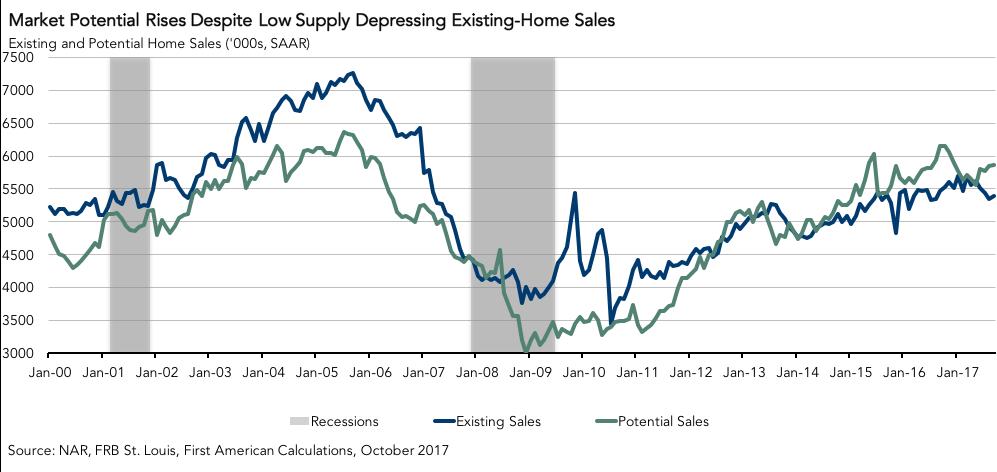First American’s proprietary Potential Home Sales model examines October 2017 data and includes analysis from First American Chief Economist Mark Fleming on how the real estate market is performing versus its potential.
October 2017 Potential Home Sales
For the month of October, First American updated its proprietary Potential Home Sales model to show that:
- Potential existing-home sales increased to a 5.89 million seasonally adjusted, annualized rate (SAAR), a 0.4 percent month-over-month increase.
- This represents a 95.7 percent increase from the market potential low point reached in December 2008.
- In October, the market potential for existing-home sales decreased by 4.3 percent compared with a year ago, a loss of 262,000 (SAAR) sales.
- Currently, potential existing-home sales is 481,000 (SAAR), or 8.2 percent, below the pre-recession peak of market potential, which occurred in July 2005.
Market Performance Gap
- The market for existing-home sales is underperforming its potential by 7.7 percent or an estimated 455,000 (SAAR) sales.
- Market potential increased by an estimated 26,000 (SAAR) sales between September 2017 and October 2017.
"The housing market has been underperforming its potential since May and this month’s market performance gap is the largest since November 2016."
Tight Inventory Continues to Put Pressure on Affordability
“Tight supply and strong first-time home buyer demand continue to be the dominant factors driving the current state of the housing market. Existing homeowners remain reluctant to list their homes for sale for fear of not being able to find a home to buy, keeping supply levels low. At the same time, a healthy number of potential home buyers continue to enter the market, so house prices are increasing and affordability is declining,” said Mark Fleming, chief economist at First American. “Historically low rates offer some relief in the form of strong borrowing power, however rates are expected to rise in the months to come, so if you are renting and thinking of buying, now is the time.”

Chief Economist Analysis Highlights
- The housing market’s potential for existing-home sales increased moderately between September 2017 and October 2017, as mortgage rates remained below 4 percent for the fifth consecutive month and the economy continued to improve.
- The housing market has been underperforming its potential since May and this month’s market performance gap is the largest since November 2016.
- Tight supply continues to weigh on the market, depressing actual existing-home sales, while the market’s potential gains strength. The number of homes for sale has declined on a year-over-year basis for 38 consecutive months.
- Active inventory has fallen 7.6 percent, and homes are selling 7.6 percent faster than a year ago, according to Realtor.com.
- The lack of inventory relative to demand is driving the fast pace of price appreciation. While low rates have kept consumer house-buying power strong, it has not offset rising prices, so affordability has suffered.
- According to the First American Real House Price Index, affordability is down 9.6 percent in August compared with a year ago.
What Insight Does the Potential Home Sales Model Reveal?
When considering the right time to buy or sell a home, an important factor in the decision should be the market’s overall health, which is largely a function of supply and demand. Knowing how close the market is to a healthy level of activity can help consumers determine if it is a good time to buy or sell, and what might happen to the market in the future. That’s difficult to assess when looking at the number of homes sold at a particular point in time without understanding the health of the market at that time. Historical context is critically important. Our potential home sales model measures what we believe a healthy market level of home sales should be based on the economic, demographic, and housing market environments.
About the Potential Home Sales Model
Potential home sales measures existing-homes sales, which include single-family homes, townhomes, condominiums and co-ops on a seasonally adjusted annualized rate based on the historical relationship between existing-home sales and U.S. population demographic data, income and labor market conditions in the U.S. economy, price trends in the U.S. housing market, and conditions in the financial market. When the actual level of existing-home sales are significantly above potential home sales the pace of turnover is not supported by market fundamentals and there is an increased likelihood of a market correction. Conversely, seasonally adjusted, annualized rates of actual existing-home sales below the level of potential existing-home sales indicate market turnover is underperforming the rate fundamentally supported by the current conditions. Actual seasonally adjusted, annualized existing-home sales may exceed or fall short of the potential rate of sales for a variety of reasons, including non-traditional market conditions, policy constraints and market participant behavior. Recent potential home sale estimates are subject to revision in order to reflect the most up-to-date information available on the economy, housing market and financial conditions. The Potential Home Sales model is published prior to the National Association of Realtors’ Existing-Home Sales report each month.



